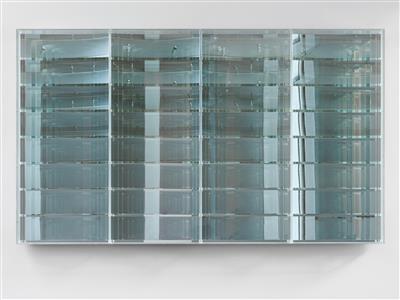Adolf Luther *

(Uerdingen 1912–1990 Krefeld)
Concave mirror object (in four rows), 1990, signed, dated Luther 90 on the reverse, 8 x 4 semi-translucent rectangular concave mirrors, mirror, plexiglass, wood, stamped on the reverse: “energetische Plastik” and “sehen ist schön”, 93 x 159 x 9 cm, in original plexiglass box, (PS)
The work is registered by the Adolf Luther Foundation, Krefeld under no. HSP 90/010.
Provenance:
Galerie Kremer-Tengelmann, Gelsenkirchen, directly from the artist
- acquired there by the present owner
Private Collection, North Rhine-Westphalia
“The involvement of the spectator follows from a functional perspective. The interaction of light and matter is fundamental. The spectator participates in this action. He or she not only stands at a distance from the world, but is also a part of it. Similarly, a specific view of the plastic follows, an expanded form of spectatorship, complete and no longer isolated.“
Adolf Luther, Das Licht kann kein Bild sein – Notizen aus vierzig Jahren, Cologne 1984, p. 186
Adolf Luther assumes a free, open, undetermined worldview that coexists with a classic perspectivistic one. His work imagines light as a plastic medium, which forms an undetermined space within space. With the serial sequence of the concave mirrors, much like the 8 x 4 semi-transparent and semi-translucent concave mirrors, “Luther proposed a sense of simplicity in order to exclude any intrinsic aesthetic value, determined by such an individual composition. This is because the concave mirrors serve, in the first instance, as instruments. They face the room in front of them, which they […] reflect as well as optically dynamise. On the one hand, the instrumental function of the concave mirrors consists in the multiplication of a given reality into a multiplicity of unreal, often inverted phenomena that irritate the spectator, and, on the other hand, in the creation of a kind of pure phenomenality within the space, thereby transforming the space itself into an otherwise invisible, light-flooded realm of energy. […] By way of instruments, themselves first to be invented by the artist, Luther’s Kunstwollen, his artistic will, aims to reveal the light in the room as energy. With this aim, Luther’s Kunstwollen relates to nature, not in a mimetic sense, but in its intention to make visible what is part of nature itself.“
(Max Imdahl, Bemerkungen über Luthers Spiegelobjekte, in exhib. cat. Luther Städtische Kunsthalle Düsseldorf, 1974, p. 5)
01.06.2016 - 19:00
- Estimate:
-
EUR 60,000.- to EUR 80,000.-
Adolf Luther *
(Uerdingen 1912–1990 Krefeld)
Concave mirror object (in four rows), 1990, signed, dated Luther 90 on the reverse, 8 x 4 semi-translucent rectangular concave mirrors, mirror, plexiglass, wood, stamped on the reverse: “energetische Plastik” and “sehen ist schön”, 93 x 159 x 9 cm, in original plexiglass box, (PS)
The work is registered by the Adolf Luther Foundation, Krefeld under no. HSP 90/010.
Provenance:
Galerie Kremer-Tengelmann, Gelsenkirchen, directly from the artist
- acquired there by the present owner
Private Collection, North Rhine-Westphalia
“The involvement of the spectator follows from a functional perspective. The interaction of light and matter is fundamental. The spectator participates in this action. He or she not only stands at a distance from the world, but is also a part of it. Similarly, a specific view of the plastic follows, an expanded form of spectatorship, complete and no longer isolated.“
Adolf Luther, Das Licht kann kein Bild sein – Notizen aus vierzig Jahren, Cologne 1984, p. 186
Adolf Luther assumes a free, open, undetermined worldview that coexists with a classic perspectivistic one. His work imagines light as a plastic medium, which forms an undetermined space within space. With the serial sequence of the concave mirrors, much like the 8 x 4 semi-transparent and semi-translucent concave mirrors, “Luther proposed a sense of simplicity in order to exclude any intrinsic aesthetic value, determined by such an individual composition. This is because the concave mirrors serve, in the first instance, as instruments. They face the room in front of them, which they […] reflect as well as optically dynamise. On the one hand, the instrumental function of the concave mirrors consists in the multiplication of a given reality into a multiplicity of unreal, often inverted phenomena that irritate the spectator, and, on the other hand, in the creation of a kind of pure phenomenality within the space, thereby transforming the space itself into an otherwise invisible, light-flooded realm of energy. […] By way of instruments, themselves first to be invented by the artist, Luther’s Kunstwollen, his artistic will, aims to reveal the light in the room as energy. With this aim, Luther’s Kunstwollen relates to nature, not in a mimetic sense, but in its intention to make visible what is part of nature itself.“
(Max Imdahl, Bemerkungen über Luthers Spiegelobjekte, in exhib. cat. Luther Städtische Kunsthalle Düsseldorf, 1974, p. 5)
|
Buyers hotline
Mon.-Fri.: 10.00am - 5.00pm
kundendienst@dorotheum.at +43 1 515 60 200 |
| Auction: | Contemporary Art - Part I |
| Auction type: | Saleroom auction |
| Date: | 01.06.2016 - 19:00 |
| Location: | Vienna | Palais Dorotheum |
| Exhibition: | 21.05. - 01.06.2016 |
